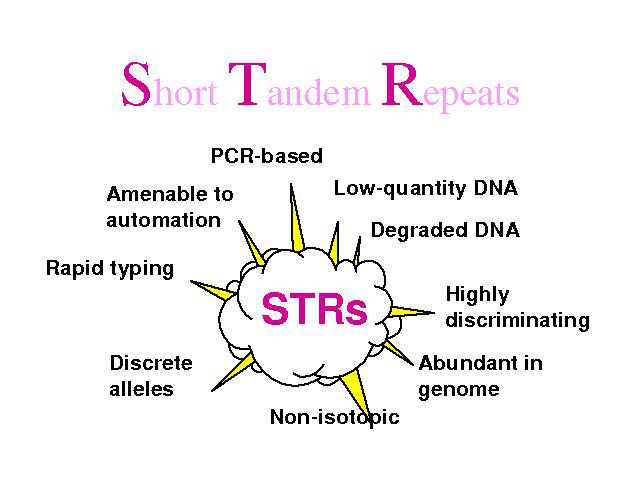 |
| Previous Image | Next Image |
| Description: The human genome is full of repeated DNA sequences which come in various sizes. Those genome are classified according to the length of the core repeat units, the number of contiguous repeat units, or the overall length of the repeat region. And DNA regions with short repeat units (usually 2-6 bp in length) are called Short Tandem Repeats (STR). Short tandem repeat analysis is a molecular biology method used to compare specific loci on DNA from two or more samples. A short tandem repeat consists of a unit of two to thirteen nucleotides repeated hundreds of times in a row on the DNA strand. STR analysis is used to measure the exact number of repeating units. This method differs from restriction fragment length polymorphism analysis (RFLP) since STR analysis does not cut the DNA with restriction enzymes. Instead, it employs probes and a polymerase chain reaction (PCR) to discover the lengths of the short tandem repeats. STR and Forensic Analysis STR analysis is also a tool in forensic analysis that evaluates specific STR regions found on nuclear DNA. The polymorphic nature of the STR regions that are analyzed for forensic testing intensifies the discrimination between one DNA profile and another. Forensic analysis takes advantage of the population\'s variability in STR lengths, enabling scientists to distinguish one DNA sample from another. STRs are the type of DNA used in most of the currently popular forensic DNA tests. Human DNA has a variety of STRs scattered among DNA sequences that encode cellular functions. For reasons that are not entirely understood, people vary from one another in the number of repeats they have, at least for some STR loci. Thus, STRs are often variable and these variations are used to distinguish people. STRs have also been analyzed by DNA sequencing. STR DNA Profiling Analysis and Human Cell Lines Since 1951 when the first human cell line was established there has been an increase in the use of human cell lines as models for human diseases such as cancer, substrates and as tools for the production of recombinant proteins for therapeutics. Unfortunately this accelerated use of human cell lines and the lack of best practices in tissue culture have led to increase in cellular cross-contamination. Now, STR DNA profiling of human cell lines can help improve the detection of cellular cross-contamination resulting in more accurate assays. STR DNA profiling is now a powerful, inexpensive tool that can generate unique DNA signatures that can be used to authenticate cell lines and detect contamination of more than one cell type. STR analysis is critical for verifying the identity of human cell lines, ensuring uniqueness of the cell line and detecting laboratory errors such as misidentification and cross-contamination of lines. The sensitivity and high power of discrimination makes STR analysis an ideal choice for the types of applications discussed here.Creative Bioarray, the US based bio-tech service supplier, offers qualified STR analysis service. For this service, you may look at http://www.creative-bioarray.com/Services/Short-Tandem-Repeat-Analysis.htm Picture Stats: Views: 2979 Filesize: 89.63kB Height: 480 Width: 640 Source: https://biology-forums.com/index.php?action=gallery;sa=view;id=20941 Keywords: STR DNA Analysis STR analysis service Creative Bioarray |
